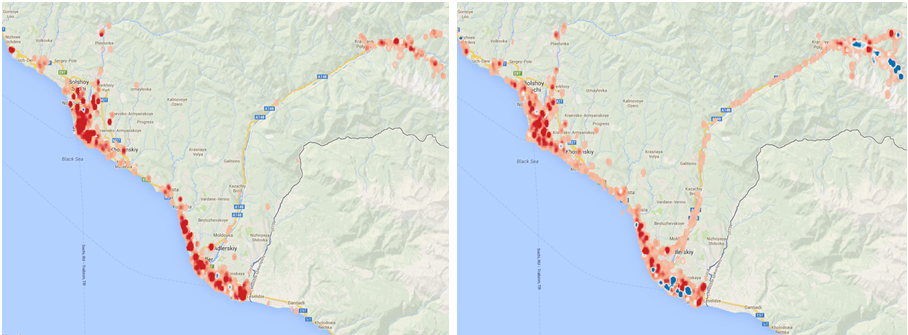September 2005 February 2014
DIVERSITY OF LANGUAGE Another way that social media can enhance our understanding of an area is by analyzing the languages that are used in a given location. In some places only one language is common, and any occurrence of out-of-place languages could merit further analysis.
In other places, many languages may be observed, allowing us to analyze the linguistic diversity of the area. By looking at the languages used in a particular area over time, we can identify ethnic enclaves and improve our insight into the human landscape of an area, which can further be analyzed for change over time. In the case of the Sochi Olympics, this change was dramatic. According to Chad Shuey, a Geospatial Scientist at DigitalGlobe, “In the course of three weeks we saw the area around Sochi transform from a relatively homogeneous corner of Russia, to one of the most linguistically and culturally diverse places on the planet, and then back again.”Russian vs Other Languages, before and during games (Red=Russian, Blue=Other)
Olympic Village Area Language Diversity. orange = 1 unique language, red = many unique languages used.
SENTIMENTS AND ENRICHMENTS Since the dawn of the Arab Spring, social media analysis has showed a focus on related sentiment. Recorded Future’s social media data is often geolocated and is enriched with additional metadata including positive and negative sentiment, and violence and protest indices, among other things. Using such sentiment information, we analyzed Sochi and the surrounding region and determined that, perhaps not surprisingly, sentiment around the Olympics was very positive but it varied in other parts of the region. This geographic analysis of sentiment revealed patterns that helped show us where to focus our attention (and satellites!).Social Media Sentiment in the Sochi Region (Green is Positive, Purple is Negative, Gray is neutral)
One interesting location was the nearby city of Krasnodar, which is generally positive, but had negative sentiment in the run up to the games. Additional analysis of this location using Recorded Future revealed some possible explanations of this negative sentiment. These included references to the firm that was contracted to euthanize stray dogs in Sochi, which is headquartered in Krasnodar. The analysis of information such as RecordedFuture’s geotagged social media data can provide DigitalGlobe and our customers with information about places and people that can’t be observed in imagery. This information can be used to monitor unrest, characterize the human landscape, and ultimately enhance our understanding of our changing planet.



